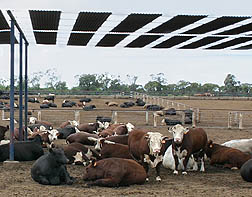This page has been archived and is being provided for reference purposes only. The page is no longer being updated, and therefore, links on the page may be invalid.
|
Read the magazine story to find out more. |
|
|
|
|
Keeping Cattle Cool and Stress-Free is Goal of ARS Study
By Chris GuyMarch 25, 2010
Identifying the causes of heat stress in cattle and finding ways to manage it are the goals of Agricultural Research Service (ARS) scientists and cooperators who are helping producers deal with this significant production problem.
Heat stress can have serious consequences. While some cattle exhibit little or no response to it, others may experience diminished appetite and feed intake, reduced growth rate, compromised disease resistance and, in extreme cases, death.
Extremely high temperatures overwhelm an animal's natural ability to regulate its body temperature. But other factors are involved, and understanding them is essential for predicting, preventing and responding to potential heat-stress scenarios, according to scientists at the ARS Roman L. Hruska U.S. Meat Animal Research Center (USMARC) in Clay Center, Neb.
There, scientists are working together with cooperators to develop risk-assessment tools and management strategies for producers. This work has three main components: analyzing animal susceptibility, identifying contributing environmental factors, and evaluating management techniques.
In one study, USMARC agricultural engineer Tami Brown-Brandl and colleagues conducted several studies to identify factors that contribute to animal susceptibility to heat stress. They identified 11 influential factors, including coat color, health history, and temperament.
In another study, Brown-Brandl and USMARC agricultural engineers Roger Eigenberg and John Nienaber looked at environmental factors affecting the intensity of heat stress. They developed a model that incorporates predictions of how temperature, humidity, sun intensity, and wind speed will affect heat stress. The model is available online at: www.ars.usda.gov/Main/docs.htm?docid=17130.
Read more about this research in the March 2010 issue of Agricultural Research magazine.
ARS is the principal intramural scientific research agency of the U.S. Department of Agriculture. The research supports the USDA priorities of promoting international food security and responding to climate change.

